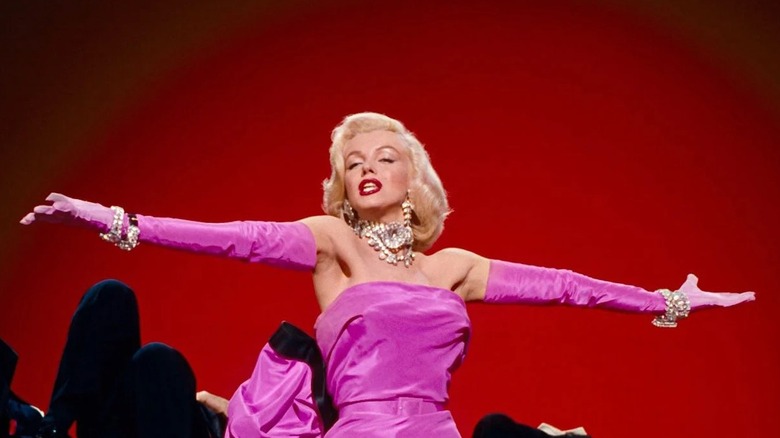Gentlemen Prefer Blondes Called For A Complete Reinvention Of Marilyn Monroe
1953 was an important year for Marilyn Monroe. She'd been appearing in films since 1947, but '53 is when she became a star. That year, she appeared in three films for 20th Century Fox and one of them stands tall as defining her legendary screen persona: director Howard Hawks' "Gentlemen Prefer Blondes."
Monroe plays Lorelei Lee, the titular blonde and one of the film's two co-leads; the other is her brunette best friend Dorothy Shaw (Jane Russell). Lorelei is a bit ditzy and not shy about her expensive tastes (in men and otherwise), but there's no more loyal friend around.
Earlier that year, Monroe starred in the technicolor thriller "Niagara" as the murderous Rose Loomis, who conspires with her lover (Richard Allen) to murder her husband (Joseph Cotton). Hawks' film, though, was a musical comedy. Since she was playing a totally different type of character, Monroe needed to show a different side of herself.
A new look
Barbara Leaming's eponymous biography of Marilyn Monroe goes into detail about how the actress prepared for "Gentlemen Prefer Blondes." According to Leaming, Monroe's makeover came down to Howard Hawks' personal tastes. The director had a thing for "sophisticated" women — his ex-wife Slim Keith was a fashion model and socialite. Accordingly, Hawks wanted his leading lady to have that look, not that of a "pin-up girl":
"In 'Gentlemen Prefer Blondes,' the keynote of Marilyn's costumes would be simplicity. Her dresses would be flashy enough, but only in terms of color and sparkle; otherwise the emphasis was on strong, simple, clean lines. Hawks also ordered a total makeover. Marilyn sat patiently as various makeups were tried out, her hair set and colored, until the director pronounced every element exactly right."
These costuming and makeup choices are clearest in the film's most well-remembered musical number: "Diamonds Are A Girl's Best Friend." During the scene, Monroe wears a sleek, strapless pink dress with long opera gloves: revealing enough to be enticing but modest enough to be respectable (by Hawks' standards, at least). She, naturally, also wears a diamond necklace, earrings and a bracelet on each wrist. Her smoothly polished hair reflects golden light. As one last touch, she carries a hand fan like a Victorian socialite. Compared to Monroe's pink dress in "Niagara," the "Diamonds" costume definitely reflects higher class.
This scene illustrates the other challenge which Monroe faced: she didn't just have to act, she had to sing and learn dance choreography, too. To succeed, Monroe pushed herself further than anyone else in the cast.
Working herself to exhaustion
Monroe wasn't a trained dancer, but that's exactly what her character was. The movie even opens with "Two Little Girls from Little Rock," a duet song and dance with Russell. For a good first impression on the audience, Monroe needed to dance convincingly. Leaming writes:
"Marilyn practiced her dance numbers with Jane Russel and the choreographer Jack Cole. Marilyn, honest about her weakness as a dancer, drove herself to exhaustion. She insisted on going over every number countless times. Russell would finally reach a point where she was unable to continue, but Marilyn, unwilling to go home, would beg Cole to stay on for another few hours in order to work with her alone. She simply would not permit herself to be tired. She seemed to believe that, through an act of will, she could transcend her limitations."
While dancing didn't come naturally, another key part of the movie did: comedy. Leaming favorably compares Monroe to Katharine Hepburn, who reportedly struggled to get into the proper comedic rhythm on Hawks' "Bringing Up Baby." Hepburn would wait for other actors' reactions before her next line, while Monroe, "didn't need Hawks to set her straight. Ignoring people's reactions, she raced from joke to joke. She radiated complete innocence of how wonderfully funny she was."
This is why "Gentlemen Prefer Blondes" defined the rest of Monroe's (tragically short) career. She proved that wasn't just sexy, she was funny. Most of her remaining movies, such as her final 1953 picture ("How To Marry A Millionaire") and her collaborations with Billy Wilder ("The Seven Year Itch" and "Some Like It Hot") were comedies. Monroe got a physical makeover for her role in "Blondes," but it was her inner talent that let her steal the show.


